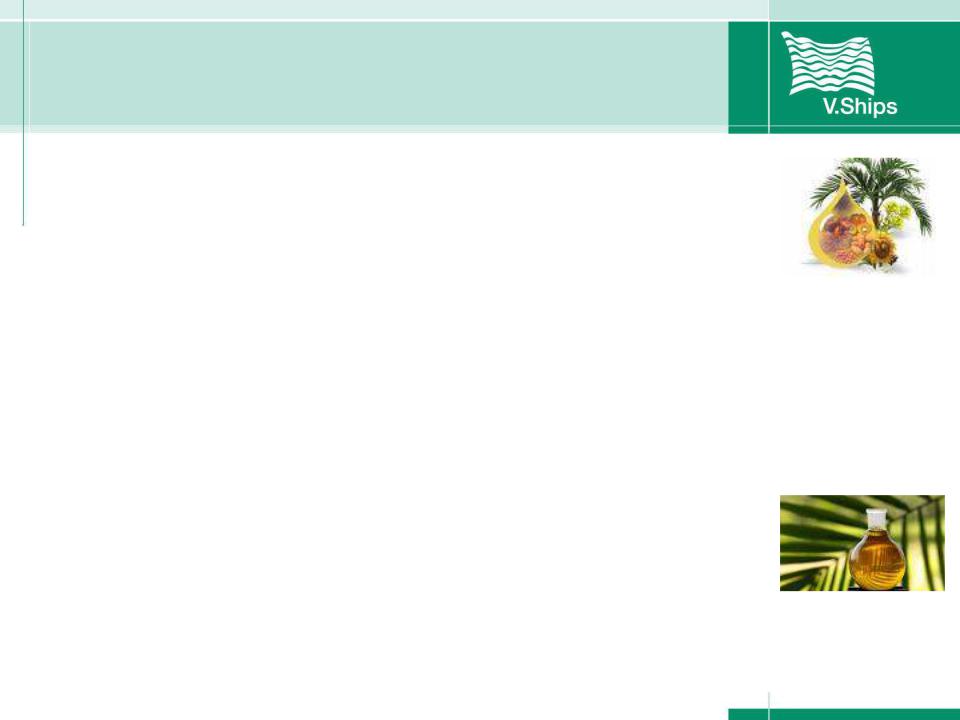
Chemical Tankers / Day 1 / Day 1 Topic 5 Cargo Properties
.pdf
Precautions during loading, discharging, sweeping, tank cleaning of various oils.
It can be requested to heat the cargoes during the voyage, always refer to a shipper’s heating instruction. The heating medium can be used as the pressurized water, steam and thermal oil. The heating coils and heat exchangers should be checked/tested prior to commence a loading. Cargo temperature should be monitored through the voyage and recorded as per the heating instruction.

Precautions during loading, discharging, sweeping, tank cleaning of various oils.
Some cargoes for e.g. the Palm Oil, has a high melting point (above 40 C), all cargo lines should be well drained after the completion of a loading, in order to avoid the cargo freezes in the cargo lines. The cargo and vapour lines should be also checked prior to commence a discharging, in order to allow a free passage of cargo and air. The line heating system (both cargo & vapour) should be activated if available.

Precautions during loading, discharging, sweeping, tank cleaning of various oils.
Oxidise – Means, absorption of oxygen from the air, and so the air remaining in the tank containing vegetable or animal oil, or coated with residual quantities of these oils, may not have enough oxygen in to support life.
|
more>>> |

Precautions during loading, discharging, sweeping, tank cleaning of various oils.
This is most likely to happen when a tank has been closed for a long time after the oils or fats have been discharged. The residual oil or fat on the structures in the tank starts to decompose (rot). When it does this, it not only absorbs oxygen, but also produces various toxic and asphyxiating gases such as methane, carbon dioxide and hydrogen sulphide.
These gases may also be present in sumps or drains, where oils and fats of this nature remain.

Precautions during loading, discharging, sweeping, tank cleaning of various oils.
Sometimes is essential to sweep the tank during / after discharging of the vegetable, animal oils and fats, as many residues can remain on the bottom of a tank. In this case the physical tank entry is required.
Therefore, it is dangerous to enter a tank, which has been used for the vegetable, or animal oils or fats unless it is being continuously ventilated.

Precautions during loading, discharging, sweeping, tank cleaning of various oils.
Before entering a tank containing any remains of vegetable or animal oils or fats, the proper confined space entry procedures should be followed (LEL/Oxygen should be monitored at all times).
While you are in the tank or space:
Carry out frequent tests to make sure that the amount of oxygen in the air is not decreasing;
Make sure that somebody remains at the tank-hatch on deck, to raise the alarm in the event of you getting difficulties.

Cleaning of various Oils
Drying oils must be cleaned with cold water. In order to prevent surface drying before cleaning begins the bulkheads must be flushed on completion of the tank inspection. Tank lids must be closed and, at the first opportunity, tank washing should be commenced.

Cleaning of various Oils
Semi-drying oils must be cleaned with cold water or water that is at the discharging temperature of the oil. In order to prevent surface drying before cleaning begins the bulkheads must be flushed on completion of the tank inspection. Tank lids must be closed and, at the first opportunity, tank washing should be commenced.
Non-Drying oils should be cleaned with hot water that is at temperature of about 78-85 C.

Cleaning of various Oils

End of Topic
